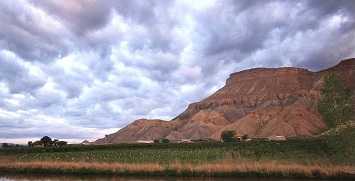Use of Model Farmers Proves Effective in Increasing Safety Practices Among Navajo Agricultural Workers
November 2014
DHHS (NIOSH) Publication Number 2015-177

Agricultural expanse in the Western United States. Photo by Thinkstock.
A Story of Impact :
Covering 27,000 square miles in Arizona, New Mexico, and Utah, the Navajo Nation, geographically, is the largest American Indian reservation in the U.S.7 Within the Navajo Nation, many use farming for personal means including food, business, and trade. Of the greater than 12,000 acres of irrigable land, fewer than 5,000 acres are being farmed due to water shortages and financial strain.5 In order to increase the yield potential of the land being used, the use of pesticides and growth agents is vital. A study by the California Department of Pesticide Regulation found that agricultural workers represented 93% of pesticide poisoning cases from 1998–2001.6
The Southwest Center for Agricultural Health, Injury Prevention and Education—funded by the National Institute for Occupational Safety and Health (NIOSH)—addressed these important topics with its Model Farmer Dissemination Project from 2006–2011. This research was developed by Dr. Deborah Helitzer—a researcher from the University of New Mexico—in collaboration with cooperative extension services from the University of Arizona and New Mexico University; the Navajo Nation Departments of Health, Agriculture, and Environmental Health; the Indian Health Service; and the Navajo Nation Farm Board, Water Board, and Human Research Review Board. This intervention specifically targeted pesticide safety and education for handling chemicals, understanding their uses, interpreting labels, proper procedures for applying pesticides, and general knowledge about how to use integrated pest management (IPM) to increase overall agricultural yield. "Model Farmers"—those viewed as trusted community members—were trained by agricultural extension agents to provide hands-on learning experiences to community farmers.
Impact
Within the participating communities of 120 farm families (average family size for Navajo Nation is 4 persons),1 significant changes were observed in pesticide use, storage behaviors, and safety and pesticide application technique during the five year study. The use of locked storage practices for pesticides increased from 60% to 94%. The use of safety equipment increased from 43% to 100%. The use of application equipment increased from 23% to 60%. Findings also showed agricultural yield increased in correctly treated plots up to 56% in corn ears and 41% in alfalfa when compared with control plots.3 In addition to the hands-on training by Model Farmers, workshops were offered during Shiprock Ag Days, an annual program run by the Shiprock cooperative extension service.
The 120 farmers who participated in this research are sufficiently well prepared to train other farmers on correct pesticide safety measures, which have proven to also increase farm yields. Given that farmers in these communities learn from their neighbors and family members, the training of these Model Farmers has significant potential to advance the workplace practices of Navajo agricultural workers, and improve the health and safety of these workers and their families.
Relevant Information
- The Model Farmer Dissemination project serves as a continuation of the Navajo Nation Evaluation—a program designed to increase the safety & welfare of agricultural workers in the Navajo Nation.
- EPA’s Current Agricultural Worker Protection Standard is a regulation aimed at reducing the risk of pesticide poisoning & injury among agricultural workers & pesticide handlers.2
- The >2 million agricultural workers & pesticide handlers who work at 600,000+ agricultural establishments are protected under the Current Agricultural Worker Protection Standard.2
View/Download Entire Document: Use of Model Farmers Proves Effective in Increasing Safety Practices Among Navajo Agricultural Workers [PDF - 262 KB]




Use of Model Farmers Proves Effective in Increasing Safety Practices Among Navajo Agricultural Workers
References
- ARPI (Arizona Rural Policy Institute) [2013]. Demographic analysis of the Navajo Nation using 2010 census and 2010 American community community survey estimates. Window Rock, AZ: Northern Arizona University. Unpublished.
- EPA [2014]. Current Agricultural Worker Protection Standard (WPS) [http://www.epa.gov/pesticides/health/worker.htm]. Date accessed: July 8, 2014.
- Helitzer DL, Hathon G, Benally J, Ortega C [2014]. Culturally relevant model program to prevent and reduce agricultural injuries. J Agric Saf Health. 20(3): 175–198.
- Hill RD, Reyes ER, Dalsey EJ [2013]. NIOSH launches worker safety and health initiative for American Indians and Alaska Natives. The IHS Prim Care Provid 38(12):205–207.
- Indian Country Cooperative Extensions [2009]. Navajo Nation [http://indiancountryextension.org/tribes/navajo-nation]. Date accessed: July 14, 2014.
- Kent R, Belitz K, Altmann AJ, Wright MT, Mendez GO [2005]. Occurrence and distribution of pesticide compounds in surface waters of the Santa Ana basin, California, 1998–2001. USGS Scientific Investigations Report 2005-5203 [http://pubs.usgs.gov/sir/2005/5203/sir2005-5203.pdf].
- Navajo Nation [2011]. History [http://www.navajo-nsn.gov/history.htm]. Date accessed: July 8, 2014.
- Page last reviewed: November 19, 2014
- Page last updated: November 19, 2014
- Content source:
- National Institute for Occupational Safety and Health Education and Information Division


 ShareCompartir
ShareCompartir